Watch a Japanese research ship fire an electromagnetic railgun
A railgun can accelerate a projectile to hypersonic speeds—that's more than five times the speed of sound.

On October 17, Japan’s military announced it had successfully test-fired a railgun on board a ship. The test was conducted by the Acquisition Technology and Logistics Agency, Japan’s rough DARPA analog, and it was carried out in conjunction with Japan Maritime Self-Defense Force. The railgun is framed specifically as a protective measure: by firing high-speed bullets, the railgun is designed to stop incoming attacks through the air or on the sea.
Most bullets are fired by a chemical propellant—a sparked reaction that ignites the dense gunpowder of a shot, which rapidly expands into gasses that propel a bullet down a gun barrel at high speeds towards a target. It’s a durable design, one continuously tweaked and iterated upon for a full millennia. Railguns still aim to propel a bullet rapidly through the air, but instead of using an explosion to do it, railguns use electromagnetic force to pull and accelerate a metal slug at great speeds and long ranges.
Here’s what it looks like, as shared by the Acquisition Technology and Logistics Agency:
Japan’s military has planned for a railgun since at least 2015, with the goal of a ship-mounted weapon as part of the idea from the start. A 2016 demonstration of a railgun accelerated its projectile to a speed of 4,470 mph, or 5.8 times the speed of sound. That is hypersonic speed, or the range at which a new class of missiles in development by nations like the US, China, and Russia are designed to fly. By making a gun that can shoot projectiles that fly faster than hypersonic missiles fly, a railgun could possibly be a tool that can shoot down such weapons. A proposal for Japan’s 2023 defense budget explicitly refers to railguns as “capable of firing projectiles at high muzzle velocity in rapid succession to counter threats such as hypersonic missiles.”
“Starting in fiscal year 2022, we have been conducting research aimed at establishing the overall technology necessary for early practical realization of railguns, including rapid fire performance and stability during flight, which are important for the practical application of railguns,” a spokesperson from Acquisition Technology and Logistics Agency told Naval News. “At the same time, we have been carrying out demonstration tests aimed at further practical application, such as carrying a railgun on board and conducting actual offshore firing. The Ministry of Defense intends to steadily work towards the early practical use of railguns in order to accelerate the strengthening of Japan’s defense capabilities.”
For the test-firing, the railgun was mounted on the JS Asuka, an Asuka-class research ship that has been a testbed for missile and sensor technologies in the past. Janes reports that crucial details of the weapon, like muzzle velocity and projectile weight, are being kept confidential. In a 2018 test, a Japanese Acquisition Technology and Logistics Agency railgun fired a projectile at a speed of Mach 6.5.
In a March 2022 video from the Agency, the design of a 2020 prototype is discussed. Part of the concern expressed is that accelerating a projectile along a rail at these speeds can cause serious erosion, which damages the weapon and limits its continued and future utility. The prototype fired a 40mm projectile, at the same 4,470 mph (or Mach 5.8) speed as in the 2016 demonstration.
Railguns can potentially be powerful guns for ships, and they could be used to protect from incoming missiles as the Acquisition Technology and Logistics Agency expresses. Such high-exit velocities also allow the bullets themselves to function as offensive hypersonic weapons in their own right, powerful slugs slamming into far-away buildings or vehicles with tremendous kinetic force.
Before aircraft carriers, gunships with powerful cannons, ultimately known as battleships, were the dominant vessel for war at sea, with guns that could bombard inland as well as devastate foes at sea. Better long-range sensors, especially radar, and the far reach of planes launched from aircraft carriers during and after World War II, mean that from the Cold War to the present shipboard guns switched from a primary threat to more circumscribed weapons, with ship-launched cruise missiles taking over the role of inland bombardment. Railguns, with the promise of powerful long-range shots that can stop missiles, sink ships, and devastate coastal defenses, offer a path back to relevance for shipboard guns.
The United States Navy has continued to pursue the development of railguns, with the intent that a projectile fired from such could intercept incoming attacks, as well as reach targets as far away as 50 to 100 nautical miles. Part of the challenge is developing a projectile that can work in railguns, as well as from existing cannons on US Navy ships.
In the meantime, the continued development of railguns as a counter-hypersonic weapon should complicate how military planners think about missiles as the answer to ships and seaborne threats.
Watch a clip from 2022 of the railgun demonstration below:

